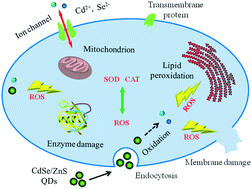Comprehensive evaluation of the cytotoxicity of CdSe/ZnS quantum dots in Phanerochaete chrysosporium by cellular uptake and oxidative stress
Abstract
The growing potential of quantum dots (QDs) in biological and biomedical applications has raised considerable concern due to their toxicological impact. Consequently, it is urgent to elucidate the underlying toxicity mechanism of QDs. In this work, we comprehensively investigated the cellular uptake of four CdSe/ZnS QDs (COOH CdSe/ZnS 525, COOH CdSe/ZnS 625, NH2 CdSe/ZnS 525, and NH2 CdSe/ZnS 625) and induced physiological responses in Phanerochaete chrysosporium (P. chrysosporium) through inductively coupled plasma optical emission spectroscopy, confocal laser scanning microscopy, and the determination of malondialdehyde content, superoxide level, superoxide dismutase activity, catalase activity and glutathione level. The results showed that the four CdSe/ZnS QDs accumulated largely in the hyphae and caused oxidative stress to P. chrysosporium in the tested concentration range (10–80 nM). Furthermore, the cellular uptake and cytotoxicity were related to the physicochemical properties of the QDs, such as particle size and surface charges. Negatively charged CdSe/ZnS QDs with small size could be more easily ingested by P. chrysosporium than large ones; thus small size CdSe/ZnS QDs were more cytotoxic to P. chrysosporium. On the other hand, small negatively charged CdSe/ZnS QDs resulted in greater cytotoxicity than large negatively charged CdSe/ZnS QDs. The obtained results offer valuable information for revealing the toxicity mechanism of QDs in living cells.



 Please wait while we load your content...
Please wait while we load your content...